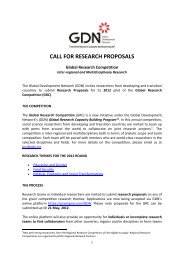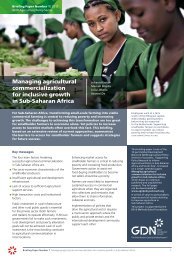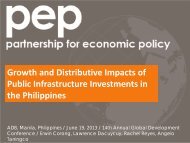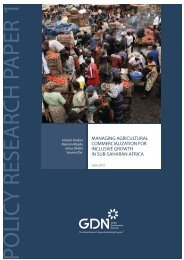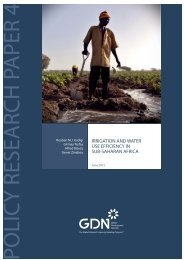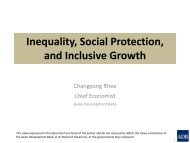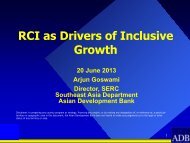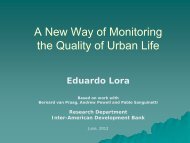Managing agricultural commercialization for inclusive growth in ...
Managing agricultural commercialization for inclusive growth in ...
Managing agricultural commercialization for inclusive growth in ...
Create successful ePaper yourself
Turn your PDF publications into a flip-book with our unique Google optimized e-Paper software.
Brief<strong>in</strong>g Paper Number 6 | 2012<br />
GDN Agriculture Policy Series<br />
<strong>Manag<strong>in</strong>g</strong> <strong>agricultural</strong><br />
<strong>commercialization</strong><br />
<strong>for</strong> <strong><strong>in</strong>clusive</strong> <strong>growth</strong><br />
<strong>in</strong> South Asia<br />
Vijay Paul Sharma<br />
D<strong>in</strong>esh Ja<strong>in</strong><br />
Sourovi De<br />
Rapid <strong>in</strong>come <strong>growth</strong>, urbanization, organized retail<strong>in</strong>g and<br />
liberalized trade are dictat<strong>in</strong>g the way food is produced, and<br />
South Asian agriculture is respond<strong>in</strong>g by becom<strong>in</strong>g <strong>in</strong>creas<strong>in</strong>gly<br />
commercialized. New markets could present an opportunity<br />
<strong>for</strong> smallholder farmers to <strong>in</strong>crease their <strong>in</strong>come, but many<br />
barriers still prevent their <strong>in</strong>clusion.<br />
Women and children sort a huge<br />
crop of red chilis <strong>in</strong> Jodhpur,<br />
India. Small and marg<strong>in</strong>al farmers<br />
have been economic pillars <strong>in</strong><br />
rural areas but risk be<strong>in</strong>g excluded<br />
from commercialized markets.<br />
jean-leo dugast | panos pictures<br />
Key messages<br />
p Strong economic <strong>growth</strong>, rapid<br />
urbanization, chang<strong>in</strong>g demographics,<br />
modern technology and the emergence<br />
of modern agri-food markets are lead<strong>in</strong>g<br />
to the <strong>commercialization</strong> of South Asian<br />
agriculture.<br />
p Commercialization has seen a significant<br />
shift <strong>in</strong> patterns of consumption, away<br />
from staple cereals towards high-value<br />
<strong>agricultural</strong> products such as fresh fruits<br />
and vegetables, milk and dairy products,<br />
meat and poultry products, processed<br />
food and beverages.<br />
p Small and marg<strong>in</strong>al farmers have been<br />
economic pillars <strong>in</strong> rural areas but face<br />
the risk of exclusion due to profound<br />
changes <strong>in</strong> the structure and governance<br />
of regional and global food cha<strong>in</strong>s.<br />
p Smallholder producers struggle to<br />
participate <strong>in</strong> the <strong>commercialization</strong><br />
process. Bottlenecks <strong>in</strong>clude<br />
<strong>in</strong>appropriate policies, lack of access<br />
to technology, <strong>in</strong>stitutional barriers,<br />
poor <strong>in</strong>frastructure and, crucially, poor<br />
l<strong>in</strong>ks to markets.<br />
p To strengthen market l<strong>in</strong>kages and<br />
encourage smallholder participation,<br />
farmers need vertical <strong>in</strong>tegration<br />
<strong>in</strong>to agri-food value cha<strong>in</strong>s, coord<strong>in</strong>ation<br />
and collective action, stronger market<br />
<strong>in</strong><strong>for</strong>mation systems, and better access<br />
to <strong>in</strong>stitutional credit.<br />
p Investment <strong>in</strong> research and development,<br />
extension services, rural <strong>in</strong>frastructure<br />
and post-harvest management is<br />
needed to ensure smallholder producers’<br />
participation <strong>in</strong> emerg<strong>in</strong>g markets.<br />
This brief<strong>in</strong>g paper is one of the<br />
10-part Global Development<br />
Network (GDN) Agriculture Policy<br />
Series <strong>for</strong> its project, ‘Support<strong>in</strong>g<br />
Policy Research to In<strong>for</strong>m<br />
Agricultural Policy <strong>in</strong> Sub-Saharan<br />
Africa and South Asia’. It is based<br />
on a longer synthesis paper,<br />
<strong>Manag<strong>in</strong>g</strong> <strong>agricultural</strong><br />
<strong>commercialization</strong> <strong>for</strong> <strong><strong>in</strong>clusive</strong><br />
<strong>growth</strong> <strong>in</strong> South Asia, which<br />
draws on extensive published<br />
and unpublished research. The<br />
full paper can be downloaded at:<br />
www.agripolicyoutreach.org<br />
It will be of value to policymakers,<br />
experts and civil society work<strong>in</strong>g to<br />
improve agriculture <strong>in</strong> South Asia.<br />
This project is supported by the<br />
Bill & Mel<strong>in</strong>da Gates Foundation.<br />
Brief<strong>in</strong>g Paper Number 6 <strong>Manag<strong>in</strong>g</strong> <strong>agricultural</strong> <strong>commercialization</strong> <strong>for</strong> <strong><strong>in</strong>clusive</strong> <strong>growth</strong> <strong>in</strong> South Asia 1
Overview<br />
A farmer <strong>in</strong> Jalandhar <strong>in</strong> India<br />
watches as his vegetables are<br />
weighed at a Reliance Fresh<br />
collection center. Called ‘<strong>for</strong>mal<br />
retail’ the stores are a break<br />
from small corner stores and<br />
open markets. One of the<br />
cha<strong>in</strong>’s greatest challenges has<br />
been sourc<strong>in</strong>g produce from<br />
local farmers, prepar<strong>in</strong>g it and<br />
transport<strong>in</strong>g it to stores.<br />
jacob silberberg | panos pictures<br />
In the past two decades, develop<strong>in</strong>g<br />
countries have witnessed a rapid <strong>in</strong>crease<br />
<strong>in</strong> the <strong>commercialization</strong> of agriculture.<br />
Ris<strong>in</strong>g <strong>in</strong>comes, chang<strong>in</strong>g tastes and<br />
lifestyles, demographic patterns and the<br />
spread of modern supply cha<strong>in</strong>s have led<br />
to this situation. In many countries <strong>in</strong> Asia,<br />
new markets have emerged <strong>for</strong> high-value<br />
commodities such as fruits, vegetables,<br />
flowers, livestock products and fisheries.<br />
The retail revolution is not only<br />
trans<strong>for</strong>m<strong>in</strong>g the way South Asian<br />
consumers buy their food, it is also<br />
dictat<strong>in</strong>g how food is produced, graded,<br />
stored and displayed. It offers a potentially<br />
excit<strong>in</strong>g w<strong>in</strong>dow <strong>in</strong>to the future of<br />
emerg<strong>in</strong>g agri-food markets. The world<br />
market <strong>for</strong> high-value food products is<br />
expand<strong>in</strong>g fast, especially <strong>in</strong> develop<strong>in</strong>g<br />
countries. This is an opportunity <strong>for</strong> South<br />
Asian countries to enhance their global<br />
share of exports of high-value agriculture.<br />
Agriculture <strong>in</strong> South Asia is dom<strong>in</strong>ated by<br />
smallholder farms, rang<strong>in</strong>g from less than<br />
one hectare <strong>in</strong> Bangladesh (0.6 hectare),<br />
Sri Lanka (0.69 hectare) and Nepal<br />
(0.79 hectare), to just above one hectare<br />
<strong>in</strong> India (1.23 hectares), while farms<br />
<strong>in</strong> Pakistan are comparatively large at<br />
3.1 hectares. Evidence shows these farm<br />
sizes are shr<strong>in</strong>k<strong>in</strong>g and fragment<strong>in</strong>g. The<br />
majority of the population live <strong>in</strong> rural<br />
areas and depend on <strong>agricultural</strong> activities<br />
as the major source of <strong>in</strong>come. Agriculture<br />
is also the ma<strong>in</strong> source of employment<br />
<strong>for</strong> the large work<strong>for</strong>ce <strong>in</strong> the region. But<br />
because there are only a few corporations,<br />
there is no effective competition <strong>in</strong><br />
agri-<strong>in</strong>put <strong>in</strong>dustries, food process<strong>in</strong>g,<br />
manufactur<strong>in</strong>g, trad<strong>in</strong>g and retail<strong>in</strong>g. This<br />
leads to skewed barga<strong>in</strong><strong>in</strong>g power between<br />
smallholders and agri-bus<strong>in</strong>ess cha<strong>in</strong>s.<br />
While it may seem like there is potential<br />
<strong>for</strong> smallholder farmers to <strong>in</strong>crease their<br />
<strong>in</strong>come and bus<strong>in</strong>esses, many barriers exist.<br />
2 Brief<strong>in</strong>g Paper Number 6 <strong>Manag<strong>in</strong>g</strong> <strong>agricultural</strong> <strong>commercialization</strong> <strong>for</strong> <strong><strong>in</strong>clusive</strong> <strong>growth</strong> <strong>in</strong> South Asia
Background to the research<br />
This paper is based on a systematic review of the literature on <strong>commercialization</strong><br />
of agriculture, analysis of secondary data from published government sources<br />
<strong>in</strong> the selected South Asian countries, and from <strong>in</strong>dividual case studies <strong>in</strong> India.<br />
The review <strong>Manag<strong>in</strong>g</strong> <strong>agricultural</strong> <strong>commercialization</strong> <strong>for</strong> <strong><strong>in</strong>clusive</strong> <strong>growth</strong> <strong>in</strong><br />
South Asia focused on four countries <strong>in</strong> South Asia: Bangladesh, India, Pakistan<br />
and Sri Lanka.<br />
The term ‘<strong><strong>in</strong>clusive</strong> <strong>growth</strong>’ can <strong>in</strong>corporate a range of concerns <strong>in</strong>clud<strong>in</strong>g poverty<br />
reduction, environmental susta<strong>in</strong>ability, food security, nutrition and governance.<br />
Researchers conduct<strong>in</strong>g the review took the term to imply a <strong>for</strong>m of <strong>agricultural</strong><br />
<strong>commercialization</strong> that <strong>in</strong>volves smallholder participation <strong>in</strong> commercial markets as<br />
well as any benefits to smallholder farmers. It puts the farmers’ <strong>in</strong>come and welfare<br />
at the center of any evaluation of agriculture.<br />
The review chose to put the smallholder farmer centre stage. Researchers used<br />
case studies to look at smallholder farmers’ participation <strong>in</strong> agri-bus<strong>in</strong>ess, the<br />
researchers and how they may have benefited. It is there<strong>for</strong>e impossible to identify<br />
general characteristics and trends from these examples.<br />
Small and marg<strong>in</strong>al<br />
farmers who have<br />
been economic pillars<br />
<strong>in</strong> rural areas face<br />
the risk of exclusion due<br />
to profound changes<br />
<strong>in</strong> the structure and<br />
governance of regional<br />
and global food cha<strong>in</strong>s.<br />
The challenges they<br />
face are many and not<br />
just because the world<br />
of commercial agriculture<br />
is unfamiliar to them.<br />
From the perspective of a smallholder<br />
farmer, commercial agriculture <strong>in</strong>volves<br />
high costs of modern <strong>in</strong>puts such as<br />
better seeds, fertilizers, irrigation and<br />
agrochemicals. In the absence of <strong>in</strong>put<br />
and credit markets, farmers f<strong>in</strong>d it difficult<br />
to purchase what they need. Access<br />
to <strong>in</strong>stitutional credit <strong>for</strong> farmers and<br />
smallholders is weak <strong>in</strong> South Asian<br />
countries and they mostly rely on highcost<br />
<strong>in</strong><strong>for</strong>mal sources of credit.<br />
In addition, grow<strong>in</strong>g high-value crops<br />
<strong>for</strong> the markets requires gett<strong>in</strong>g timely<br />
<strong>in</strong><strong>for</strong>mation on market prices and<br />
well-developed markets. However,<br />
smallholder farmers often do not have<br />
access to that <strong>in</strong><strong>for</strong>mation. Added problems<br />
are that high-value commodities are<br />
often perishable. Output markets are<br />
under-developed and fragmented and<br />
have acute shortages of post-harvest<br />
<strong>in</strong>frastructure, lead<strong>in</strong>g to high volatility<br />
<strong>in</strong> their prices and large losses.<br />
Moreover, new procurement systems<br />
often demand larger supply volumes and<br />
a uni<strong>for</strong>m product, favor<strong>in</strong>g larger farmers.<br />
It is difficult <strong>for</strong> small farmers to participate<br />
<strong>in</strong> commercial agriculture unless they f<strong>in</strong>d<br />
ways to improve their barga<strong>in</strong><strong>in</strong>g power<br />
and reduce transaction costs.<br />
Increas<strong>in</strong>g evidence from both research<br />
and practice shows that one way <strong>for</strong><br />
smallholders to overcome the problem<br />
of market failure is through organiz<strong>in</strong>g <strong>in</strong>to<br />
farmer groups or producers’ organizations.<br />
Act<strong>in</strong>g collectively, smallholders are better<br />
positioned to: reduce transaction costs <strong>for</strong><br />
their market exchanges; obta<strong>in</strong> necessary<br />
market <strong>in</strong><strong>for</strong>mation; have better barga<strong>in</strong><strong>in</strong>g<br />
power to secure access to new technologies<br />
and tap <strong>in</strong>to high-value markets.<br />
Agricultural policies <strong>in</strong> the region are<br />
there<strong>for</strong>e faced with several compet<strong>in</strong>g<br />
areas result<strong>in</strong>g <strong>in</strong> a policy quagmire.<br />
How do we enable smallholder farmers<br />
to emerge out of traditional production<br />
systems and embrace a more responsive<br />
approach to emerg<strong>in</strong>g food markets<br />
How do the goals of commercial agriculture<br />
align with ‘<strong><strong>in</strong>clusive</strong> <strong>growth</strong>’ <strong>for</strong> poor<br />
farmers The review exam<strong>in</strong>ed the<br />
challenges and barriers that smallholder<br />
farmers confront if they are to participate<br />
<strong>in</strong> commercialized <strong>agricultural</strong> systems.<br />
What specific conditions are required<br />
to support smallholder participation<br />
and <strong>in</strong>crease farmer <strong>in</strong>come and welfare<br />
What policy options would support<br />
these conditions What is the agenda<br />
<strong>for</strong> future research<br />
Brief<strong>in</strong>g Paper Number 6 <strong>Manag<strong>in</strong>g</strong> <strong>agricultural</strong> <strong>commercialization</strong> <strong>for</strong> <strong><strong>in</strong>clusive</strong> <strong>growth</strong> <strong>in</strong> South Asia 3
The challenges <strong>in</strong> more detail<br />
The grow<strong>in</strong>g demand <strong>for</strong> high-value<br />
agriculture and the ris<strong>in</strong>g importance<br />
of commercialized supply cha<strong>in</strong>s poses<br />
many questions and challenges <strong>for</strong><br />
develop<strong>in</strong>g country smallholder agriculture.<br />
Traditionally, agriculture was expected<br />
to feed the teem<strong>in</strong>g <strong>in</strong>dustrial work<strong>for</strong>ce,<br />
while provid<strong>in</strong>g markets <strong>for</strong> <strong>in</strong>dustrial<br />
outputs. Today, <strong>agricultural</strong> development<br />
is seen not just as a vehicle <strong>for</strong> support<strong>in</strong>g<br />
<strong>in</strong>dustrialization, but also as a mode<br />
of <strong><strong>in</strong>clusive</strong> <strong>growth</strong>, pro-poor economic<br />
development, food security and<br />
environmental susta<strong>in</strong>ability.<br />
McCa<strong>in</strong> India: mak<strong>in</strong>g direct l<strong>in</strong>ks with farmers<br />
When McDonald’s restaurants entered the Indian fast-food<br />
market, they discovered that potatoes traditionally grown by<br />
Indian farmers are shorter <strong>in</strong> length than the standard size<br />
required <strong>for</strong> the typical french fries served at the cha<strong>in</strong>’s<br />
restaurants. Import<strong>in</strong>g potatoes <strong>for</strong> every pack of fries sold<br />
was not an option and us<strong>in</strong>g shorter potatoes <strong>for</strong> produc<strong>in</strong>g<br />
fries was also rejected. McCa<strong>in</strong> Foods India (a 100 per cent<br />
subsidiary of McCa<strong>in</strong> Foods Canada), suppliers to McDonald’s,<br />
decided that a home-grown alternative was the way <strong>for</strong>ward.<br />
McCa<strong>in</strong> <strong>in</strong>vested <strong>in</strong> research and development to identify<br />
the best varieties of potatoes suitable <strong>for</strong> French fries and other<br />
high-end products. The company developed strong vertical<br />
l<strong>in</strong>ks with smallholder potato farmers <strong>in</strong> north Gujarat.<br />
They worked through contract farm<strong>in</strong>g arrangements to<br />
provide the farmers with seed supply, extension services, quality<br />
control, storage and process<strong>in</strong>g facilities. The company tra<strong>in</strong>ed<br />
farmers <strong>in</strong> better plant<strong>in</strong>g methods, irrigation systems, fertilizer<br />
application programs and seed treatments. This led to <strong>in</strong>creased<br />
crop productivity (from about 18 tonnes per hectare to over<br />
40 tonnes per hectare) and higher profits <strong>for</strong> farmers. McCa<strong>in</strong>’s<br />
contract farm<strong>in</strong>g <strong>in</strong>itiative has brought a new way of farm<strong>in</strong>g<br />
to India and its potato growers.<br />
Hitesh Patel, a contract farmer, used to grow cotton on<br />
his six-hectare farm. Four years ago, he planted one hectare<br />
of potatoes under the guidance of McCa<strong>in</strong> agronomists.<br />
Now he plants potatoes on all of the 6 hectares he owns and<br />
another 1.6 hectares he has leased. McCa<strong>in</strong> Foods offers him<br />
an assured price, and improved productivity and farm <strong>in</strong>come.<br />
Farmers told researchers that as a result they had bought<br />
new vehicles, land and cattle as well as <strong>in</strong>vest<strong>in</strong>g <strong>in</strong> larger<br />
homes. It took McDonald’s roughly six years and US$100 million<br />
to set up a reliable supply cha<strong>in</strong>, with companies like McCa<strong>in</strong><br />
facilitat<strong>in</strong>g the process. But this case study shows that<br />
the private sector can play an important role <strong>in</strong> provid<strong>in</strong>g<br />
technology, extension services and the required market<br />
l<strong>in</strong>kages to smallholder farmers.<br />
In develop<strong>in</strong>g countries a significant<br />
number of the work<strong>in</strong>g population reside<br />
<strong>in</strong> rural areas and depend on agriculture <strong>for</strong><br />
their livelihood. While smallholder farmers,<br />
who might own less than two hectares<br />
of land, have been and cont<strong>in</strong>ue to be<br />
responsible <strong>for</strong> a large share of <strong>agricultural</strong><br />
production, their impact on market supplies<br />
has been limited.<br />
But <strong>in</strong>creas<strong>in</strong>gly, <strong>agricultural</strong><br />
<strong>commercialization</strong> is discussed as<br />
a potential pathway out of poverty <strong>for</strong><br />
these smallholder cultivators.<br />
This <strong>in</strong>cludes: the trend towards non-staple<br />
western dietary habits among grow<strong>in</strong>g<br />
urban populations; ris<strong>in</strong>g household<br />
<strong>in</strong>comes; <strong>for</strong>eign <strong>in</strong>vestment <strong>in</strong> food<br />
markets, the emergence of supermarkets;<br />
and vertical <strong>in</strong>tegration of production<br />
and retail <strong>in</strong> agriculture.<br />
The drivers of <strong>agricultural</strong> <strong>commercialization</strong><br />
<strong>in</strong> South Asia <strong>in</strong>clude ris<strong>in</strong>g <strong>in</strong>comes,<br />
chang<strong>in</strong>g dietary consumption patterns,<br />
urbanization, female labor <strong>for</strong>ce<br />
participation, chang<strong>in</strong>g demographics<br />
and the <strong>growth</strong> <strong>in</strong> export opportunities.<br />
The majority of agriculture <strong>in</strong> South Asia<br />
is by smallholder farmers, who struggle to<br />
participate <strong>in</strong> large-scale commercial<br />
activities. This <strong>in</strong>cludes produc<strong>in</strong>g outputs<br />
that adhere to the quality and safety<br />
specifications of the quality-conscious<br />
consumer.<br />
Poor market l<strong>in</strong>kages with smallholder<br />
farmers are a major stumbl<strong>in</strong>g block <strong>for</strong><br />
the <strong>commercialization</strong> of agriculture <strong>in</strong><br />
South Asia. Ways to improve these l<strong>in</strong>kages<br />
<strong>in</strong>clude improv<strong>in</strong>g rural <strong>in</strong>frastructure,<br />
vertical coord<strong>in</strong>ation of agri-food cha<strong>in</strong>s,<br />
strengthen<strong>in</strong>g market <strong>in</strong><strong>for</strong>mation systems<br />
and collective action by smallholders.<br />
Improv<strong>in</strong>g farmer access to f<strong>in</strong>ance and<br />
credit service is also important.<br />
It is crucial to note that <strong>growth</strong> <strong>in</strong><br />
<strong>agricultural</strong> productivity does not<br />
necessarily lead to poverty reduction.<br />
It results from the deliberate and planned<br />
use of modern technology, <strong>in</strong>vestment <strong>in</strong><br />
research and development, <strong>in</strong>frastructure,<br />
especially rural roads, better access to<br />
<strong>in</strong>puts and services and market l<strong>in</strong>kages.<br />
4 Brief<strong>in</strong>g Paper Number 6 <strong>Manag<strong>in</strong>g</strong> <strong>agricultural</strong> <strong>commercialization</strong> <strong>for</strong> <strong><strong>in</strong>clusive</strong> <strong>growth</strong> <strong>in</strong> South Asia
Vegetables are laid out <strong>for</strong><br />
sale at an open air market <strong>in</strong><br />
Dhaka, Bangladesh<br />
g m b akash | panos pictures<br />
Poor market l<strong>in</strong>kages<br />
Poor market l<strong>in</strong>kages are a critical factor<br />
<strong>in</strong> the success or otherwise of smallholder<br />
farmers participat<strong>in</strong>g <strong>in</strong> commercial<br />
agriculture. The follow<strong>in</strong>g factors <strong>in</strong>fluence<br />
how smallholder famers l<strong>in</strong>k to markets:<br />
Rural <strong>in</strong>frastructure<br />
Rural roads, power, water and storage<br />
facilities, process<strong>in</strong>g and post-harvest<br />
<strong>in</strong>frastructure are critical factors <strong>in</strong><br />
commercial agriculture. This is particularly<br />
the case <strong>for</strong> high-value perishable fruit,<br />
vegetables or livestock products. If<br />
<strong>in</strong>frastructure is poor, as it often is, farmers<br />
experience higher losses and <strong>in</strong>creased<br />
market<strong>in</strong>g costs. However, neither national<br />
governments nor <strong>in</strong>ternational aid agencies<br />
seem to prioritize <strong>in</strong>vestment <strong>in</strong> the<br />
construction of new rural <strong>in</strong>frastructure<br />
or ma<strong>in</strong>tenance of exist<strong>in</strong>g <strong>in</strong>frastructure.<br />
For example, farmers ma<strong>in</strong>ly depend on<br />
ra<strong>in</strong>-fed agriculture, yet we see very little<br />
is be<strong>in</strong>g done towards expand<strong>in</strong>g the<br />
area under irrigated cultivation. This raises<br />
crop yields, which <strong>in</strong> turn <strong>in</strong>creases labor<br />
and land productivity. It encourages<br />
diversification from traditional low-value<br />
staples to high-value crops such as fruit,<br />
vegetables, flowers and spices <strong>for</strong> the<br />
domestic and export market. Strategies<br />
should also focus on develop<strong>in</strong>g allied<br />
sectors such as dairy, meat, poultry,<br />
fish, non-farm sector, agro-<strong>in</strong>dustry<br />
and agri-bus<strong>in</strong>ess.<br />
Vertical coord<strong>in</strong>ation <strong>in</strong><br />
agri-food cha<strong>in</strong>s<br />
Vertical <strong>in</strong>tegration of bus<strong>in</strong>ess between<br />
the farmer and the retailer is <strong>in</strong>creas<strong>in</strong>gly<br />
common <strong>in</strong> agri-bus<strong>in</strong>ess. Contract farm<strong>in</strong>g<br />
is a <strong>for</strong>m of vertical <strong>in</strong>tegration where<br />
the buyer and farmer agree conditions <strong>for</strong><br />
produc<strong>in</strong>g and market<strong>in</strong>g farm products.<br />
Typically the farmer agrees to produce<br />
a certa<strong>in</strong> quantity of output, meet quality<br />
standards and a delivery schedule. The<br />
contract also sets a price or price range<br />
to be met. Sometimes the buyer <strong>in</strong>sists<br />
on particular <strong>in</strong>puts and production<br />
techniques. Critics of contract farm<strong>in</strong>g<br />
argue that smaller farmers are often unable<br />
to negotiate fair terms of trade themselves<br />
and that it is not a trans<strong>for</strong>mative approach.<br />
Others argue that the relationship is<br />
not exploitative if managed properly.<br />
Sometimes contract farm<strong>in</strong>g can be tapped<br />
as a vehicle <strong>for</strong> smallholder-led <strong>agricultural</strong><br />
<strong>commercialization</strong> as it enables large<br />
buyers of farm produce to pool the<br />
outputs of several small farmers and<br />
harness economies of small-scale. Benefits<br />
to the farmer depend on the number<br />
of <strong>in</strong>termediaries between producer and<br />
f<strong>in</strong>al buyer and the buyer’s contribution to<br />
the cost of <strong>in</strong>puts.<br />
Brief<strong>in</strong>g Paper Number 6 <strong>Manag<strong>in</strong>g</strong> <strong>agricultural</strong> <strong>commercialization</strong> <strong>for</strong> <strong><strong>in</strong>clusive</strong> <strong>growth</strong> <strong>in</strong> South Asia 5
Collective action <strong>for</strong> smallholder<br />
market access<br />
If smallholder producers organize<br />
themselves and act collectively, they<br />
are more likely to overcome some<br />
of the significant challenges they face.<br />
This <strong>in</strong>cludes lack of access to market<br />
<strong>in</strong><strong>for</strong>mation, technology and credit, high<br />
transaction costs and uneven barga<strong>in</strong><strong>in</strong>g<br />
power. Collective action can help to<br />
aggregate production volumes to<br />
establish l<strong>in</strong>ks with large buyers, reduce<br />
transaction costs on both sides of the<br />
supply cha<strong>in</strong>, and improve barga<strong>in</strong><strong>in</strong>g<br />
power. Ultimately it allows farmers to<br />
compete more effectively.<br />
Market <strong>in</strong><strong>for</strong>mation systems<br />
The importance of market <strong>in</strong><strong>for</strong>mation<br />
systems <strong>in</strong> develop<strong>in</strong>g countries <strong>in</strong>creases<br />
with the move from subsistence farm<strong>in</strong>g to<br />
commercial agriculture. As farmers engage<br />
more with <strong>commercialization</strong>, they <strong>in</strong>teract<br />
with traders and others <strong>in</strong> both <strong>in</strong>put<br />
and output markets. In<strong>for</strong>mation becomes<br />
vital to facilitate these <strong>in</strong>teractions. Access<br />
to <strong>in</strong><strong>for</strong>mation <strong>in</strong>creases the efficiency<br />
of <strong>agricultural</strong> markets.<br />
Access to f<strong>in</strong>ance<br />
Smallholder famers need access to<br />
<strong>in</strong>stitutional f<strong>in</strong>ance. High-value agriculture<br />
is capital <strong>in</strong>tensive and restricts participation<br />
of smallholders <strong>in</strong> the process as they lack<br />
access to capital.<br />
Amul cooperative: a success story<br />
of collective action<br />
In the mid-1940s <strong>in</strong> Anand, a small town <strong>in</strong> the state<br />
of Gujarat, Western India, milk became a symbol<br />
of protest aga<strong>in</strong>st a local trade cartel. Angered by<br />
unfair and manipulative trad<strong>in</strong>g practices, farmers<br />
approached the em<strong>in</strong>ent statesman, Sardar<br />
Vallabhbhai Patel, who advised them to get rid of<br />
the middlemen and <strong>for</strong>m their own cooperative. The<br />
farmers then refused to sell their milk to the trade<br />
cartel and <strong>for</strong>med the Kaira District Cooperative Milk<br />
Producers Union Limited. They started pasteuriz<strong>in</strong>g<br />
milk <strong>in</strong> June 1948 <strong>for</strong> the Bombay Milk Scheme with<br />
just a handful of farmers <strong>in</strong> two village cooperative<br />
societies, produc<strong>in</strong>g 250 liters a day. It was an<br />
assured market and by the end of 1948, 432 farmers<br />
had jo<strong>in</strong>ed and milk quantities <strong>in</strong>creased to 5000<br />
liters per day. Today <strong>in</strong> Gujurat, about three million<br />
rural producers <strong>in</strong> 15,712 dairy cooperatives farm<br />
milk under the Amul brand. In 2010–2011 they<br />
produced 9.2 million liters.<br />
The Amul model is a three-tier structure with dairy<br />
cooperative societies at the village level federated<br />
under a milk union at the district level and a<br />
federation of member unions at the state level.<br />
The model works by establish<strong>in</strong>g direct l<strong>in</strong>kages<br />
between milk producers and consumers. Milk<br />
farmers control the procurement, process<strong>in</strong>g<br />
and market<strong>in</strong>g, and the cooperative also hires<br />
professional managers. Amul assures guaranteed<br />
purchase of all milk at pre-determ<strong>in</strong>ed prices and<br />
assures high-quality products sold at competitive<br />
prices to consumers. This happens through<br />
vertical coord<strong>in</strong>ation from production to market<br />
through a vast cooperative network. This is<br />
a unique model <strong>for</strong> rural development, especially<br />
<strong>for</strong> women and small and marg<strong>in</strong>al farmers.<br />
The features of this successful model are:<br />
p Great leadership and freedom from external<br />
political and bureaucratic controls.<br />
p Farmers participat<strong>in</strong>g at all levels from production<br />
to market<strong>in</strong>g.<br />
p Autonomous, committed professional managers.<br />
p Susta<strong>in</strong>able <strong>growth</strong> through assured prices, cash<br />
payments <strong>for</strong> milk supply, provision of quality<br />
feed, breed<strong>in</strong>g and animal health care services,<br />
and support <strong>for</strong> <strong>in</strong>frastructure (bulk milk coolers,<br />
test<strong>in</strong>g facilities) at village level.<br />
p Development of a consumer base by mak<strong>in</strong>g dairy<br />
products af<strong>for</strong>dable.<br />
p Focus on core activities of production, process<strong>in</strong>g<br />
and market<strong>in</strong>g and manag<strong>in</strong>g other services<br />
such as logistics <strong>for</strong> milk collection, distribution,<br />
etc. through third party/outsourc<strong>in</strong>g.<br />
p Market-driven production system marked by<br />
transparency and accountability.<br />
See diagram on the next page <strong>for</strong> an overview<br />
of the Amul model.<br />
6 Brief<strong>in</strong>g Paper Number 6 <strong>Manag<strong>in</strong>g</strong> <strong>agricultural</strong> <strong>commercialization</strong> <strong>for</strong> <strong><strong>in</strong>clusive</strong> <strong>growth</strong> <strong>in</strong> South Asia
Recommendations<br />
Three-tier ‘Anand Pattern’<br />
of dairy development <strong>in</strong> India<br />
Milk and<br />
dairy products<br />
Milk and<br />
dairy products<br />
Market<br />
p Support <strong>in</strong>frastructure<br />
Governments should pay attention to<br />
ma<strong>in</strong>ta<strong>in</strong><strong>in</strong>g and build<strong>in</strong>g rural <strong>in</strong>frastructure<br />
that will support smallholder farmers<br />
and <strong>in</strong>crease their ability to participate<br />
<strong>in</strong> commercial agriculture.<br />
p Enable private <strong>in</strong>vestment but protect<br />
smallholders<br />
Agricultural policy <strong>in</strong> South Asia should<br />
encourage contract farm<strong>in</strong>g by offer<strong>in</strong>g<br />
an enabl<strong>in</strong>g environment <strong>for</strong> organized<br />
private <strong>in</strong>vestment as well as protect<strong>in</strong>g the<br />
<strong>in</strong>terests of smallholder producers.<br />
State cooperative milk market<strong>in</strong>g federation<br />
1 <strong>in</strong> Gujarat and 22 <strong>in</strong> India<br />
District cooperative milk union /<br />
dairy process<strong>in</strong>g plants<br />
15 <strong>in</strong> Gujarat and 177 <strong>in</strong> India<br />
Milk Base milk price<br />
Additional<br />
price difference<br />
Dividend<br />
Sales revenue<br />
Sales revenue<br />
Cattle feed<br />
Veter<strong>in</strong>ary,<br />
animal health and<br />
breed<strong>in</strong>g services<br />
Rural health services<br />
p Invest <strong>in</strong> research and extension<br />
Reorient public expenditure away from<br />
large non-targeted subsidies <strong>in</strong> agriculture<br />
towards research and extension services<br />
to enable smallholder farmers to cope<br />
with the challenges of cultivat<strong>in</strong>g highvalue<br />
crops.<br />
p Target subsidies toward smallholders<br />
Ensure subsidy programs <strong>for</strong> credit,<br />
fertilizers and irrigation are aimed<br />
at smallholder farmers. Subsidy programs<br />
should be carefully targeted to free<br />
up budgetary resources <strong>for</strong> productive<br />
<strong>agricultural</strong> <strong>in</strong>vestments.<br />
p Promote ICT<br />
Strengthen access to market <strong>in</strong><strong>for</strong>mation<br />
systems and In<strong>for</strong>mation and<br />
Communication Technology (ICT).<br />
p Encourage farmer organization<br />
Provide support to farmers’ ef<strong>for</strong>ts<br />
to take collective action through groups,<br />
organizations and networks.<br />
p Improve smallholders’ access to f<strong>in</strong>ance<br />
Ef<strong>for</strong>ts are needed to improve smallholders’<br />
access to <strong>in</strong>stitutional f<strong>in</strong>ance. The active<br />
participation of different organizations such<br />
as public and private banks, cooperatives,<br />
non-governmental organizations, microf<strong>in</strong>ance<br />
<strong>in</strong>stitutions, self-help groups etc.<br />
can all help improve access to f<strong>in</strong>ance.<br />
p Research smallholder participation<br />
Further documentation and research is<br />
needed to exam<strong>in</strong>e the level of smallholder<br />
participation <strong>in</strong> the supermarket revolution<br />
<strong>in</strong> South Asia, <strong>in</strong> order to <strong>for</strong>mulate<br />
evidence-based policies.<br />
Village dairy cooperative society<br />
15,712 <strong>in</strong> Gujarat and 144,240 <strong>in</strong> India<br />
Milk Base milk price<br />
Additional<br />
price difference<br />
Dividend<br />
Cattle feed<br />
Veter<strong>in</strong>ary,<br />
animal health and<br />
breed<strong>in</strong>g services<br />
Rural health services<br />
Member milk producers<br />
3 million <strong>in</strong> Gujarat and 15 million <strong>in</strong> India<br />
Source: Amul (2012)<br />
Brief<strong>in</strong>g Paper Number 6 <strong>Manag<strong>in</strong>g</strong> <strong>agricultural</strong> <strong>commercialization</strong> <strong>for</strong> <strong><strong>in</strong>clusive</strong> <strong>growth</strong> <strong>in</strong> South Asia 7
Key references<br />
J Fei and G Ranis (1961)<br />
‘ A theory of economic development’,<br />
American Economic Review, vol 514,<br />
pp533–65<br />
Ashok Gulati, Nicolas M<strong>in</strong>ot,<br />
Chris Delgado and Saswati Bora (2005)<br />
‘ Growth <strong>in</strong> high-value agriculture <strong>in</strong><br />
Asia and the emergence of vertical<br />
l<strong>in</strong>ks with farmers’, paper presented<br />
at the Workshop on L<strong>in</strong>k<strong>in</strong>g Small-<br />
Scale Producers to Markets: Old and<br />
New Challenges, The World Bank,<br />
Wash<strong>in</strong>gton DC, 15 December 2005<br />
P K Joshi, Ashok Gulati and<br />
Ralph Cumm<strong>in</strong>gs Jr (2007)<br />
‘ Agricultural diversification <strong>in</strong> South Asia:<br />
Beyond food security’, <strong>in</strong> PK Joshi, Ashok<br />
Gulati and Ralph Cumm<strong>in</strong>gs Jr (eds)<br />
Agricultural diversification and smallholder<br />
<strong>in</strong> South Asia, New Delhi: Academic<br />
Foundation, pp47–81<br />
Praduman and Mruthyunjaya Kumar (2002)<br />
‘ Long-term changes <strong>in</strong> food basket<br />
<strong>in</strong> India’, paper presented at the<br />
International Workshop on Agricultural<br />
Diversification and Vertical Integration<br />
<strong>in</strong> South Asia organized by FICCI-ICRISAT-<br />
IFPRI, 5–6 November, New Delhi, India<br />
W A Lewis (1954)<br />
‘ Economic development with unlimited<br />
supplies of labour’, Manchester School<br />
of Economics, vol 20, pp139–91<br />
Anwar Naseem, Steven Were Omamo<br />
and David J Spielman (2006)<br />
The private sector <strong>in</strong> <strong>agricultural</strong><br />
R&D: Policies and <strong>in</strong>stitutions to foster<br />
its <strong>growth</strong> <strong>in</strong> develop<strong>in</strong>g countries,<br />
ISNAR Discussion Paper 6,<br />
Wash<strong>in</strong>gton DC: International<br />
Food Policy Research Institute<br />
P P<strong>in</strong>gali (2006)<br />
‘ Agricultural <strong>growth</strong> and economic<br />
development: A view through the<br />
globalization lens’, paper presented<br />
at 26th International Conference of<br />
Agricultural Economists, 12–18 August,<br />
Gold Coast, Australia<br />
Vijay Paul Sharma (2012)<br />
‘ India’s <strong>agricultural</strong> development<br />
under the new economic regime:<br />
Policy perspective and strategy<br />
<strong>for</strong> the 12th five year plan’, Indian<br />
Journal of Agricultural Economics,<br />
vol 67, no 1, January–March, pp46–78.<br />
The full paper <strong>Manag<strong>in</strong>g</strong> <strong>agricultural</strong><br />
<strong>commercialization</strong> <strong>for</strong> <strong><strong>in</strong>clusive</strong> <strong>growth</strong><br />
<strong>in</strong> South Asia is available <strong>for</strong> download at<br />
www.agripolicyoutreach.org<br />
It was written by:<br />
Prof. Vijay Paul Sharma<br />
Indian Institute of Management, India<br />
D<strong>in</strong>esh Ja<strong>in</strong><br />
Indian Institute of Management, India<br />
Sourovi De<br />
University of Ox<strong>for</strong>d, UK<br />
and reviewed by<br />
Prof. Per P<strong>in</strong>strup-Andersen<br />
Cornell University, USA<br />
Project Steer<strong>in</strong>g Committee<br />
Senior Advisors<br />
Prof. Per P<strong>in</strong>strup-Andersen<br />
Cornell University, USA<br />
Prof. Thomas S. Jayne<br />
Michigan State University, USA<br />
Prof. William A. Masters<br />
Tufts University, USA<br />
Prof. Alexandros Sarris<br />
University of Athens, Greece<br />
Prof. David Zilberman<br />
University of Cali<strong>for</strong>nia, Berkeley, USA<br />
Project Management Team<br />
Pr<strong>in</strong>cipal Advisor<br />
Prof. Douglas Goll<strong>in</strong><br />
Williams College, USA<br />
Project Director<br />
Dr. George Mavrotas<br />
Chief Economist, GDN<br />
Deputy Project Director<br />
Tuh<strong>in</strong> Sen<br />
Lead Strategist, GDN<br />
tsen@gdn.<strong>in</strong>t<br />
Project Consultant<br />
Nupur Suri<br />
Policy Outreach Analyst<br />
V<strong>in</strong>a<strong>in</strong>a Suri<br />
If you wish to reproduce or build upon this work,<br />
please contact Global Development Network (GDN).<br />
© Global Development Network<br />
Designed and produced <strong>for</strong> GDN by Panos London,<br />
panos.org.uk<br />
All photographs © Panos Pictures, panos.co.uk<br />
All rights reserved.<br />
Further <strong>in</strong><strong>for</strong>mation<br />
For more <strong>in</strong><strong>for</strong>mation on the ‘Support<strong>in</strong>g Policy<br />
Research to In<strong>for</strong>m Agricultural Policy <strong>in</strong> Sub-Saharan<br />
Africa and South Asia’ project and <strong>for</strong> free<br />
download of the Agricultural Policy Research App<br />
(<strong>for</strong> iPad, iPhone, K<strong>in</strong>dle and Android) visit:<br />
www.agripolicyoutreach.org<br />
New Delhi | Cairo | Wash<strong>in</strong>gton DC<br />
www.gdn.<strong>in</strong>t<br />
8 Brief<strong>in</strong>g Paper Number 6 <strong>Manag<strong>in</strong>g</strong> <strong>agricultural</strong> <strong>commercialization</strong> <strong>for</strong> <strong><strong>in</strong>clusive</strong> <strong>growth</strong> <strong>in</strong> South Asia



